





Published on Apr 02, 2024
Tangent galvanometer is an early measuring instrument for small electric currents. It consists of a coil of insulated copper wire wound on a circular non-magnetic frame. Its working is based on the principle of the tangent law of magnetism. When a current is passed through the circular coil, a magnetic field (B) is produced at the center of the coil in a direction perpendicular to the plane of the coil. The TG is arranged in such a way that the horizontal component of earth’s magnetic field (Bh) is in the direction of the plane of the coil.
1. To determine the reduction factor of the given tangent galvanometer (K).
2. To find out the horizontal component of earth’s magnetic field (Bh).
Tangent galvanometer is an early measuring instrument for small electric currents. It consists of a coil of insulated copper wire wound on a circular non-magnetic frame. Its working is based on the principle of the tangent law of magnetism. When a current is passed through the circular coil, a magnetic field (B) is produced at the center of the coil in a direction perpendicular to the plane of the coil. The TG is arranged in such a way that the horizontal component of earth’s magnetic field (Bh) is in the direction of the plane of the coil. The magnetic needle is then under the action of two mutually perpendicular fields. If θ is the deflection of the needle, then according to tangent law,
![]()
Let I is the current passing through the coil of radius a with n turns, then the field generated by the current carrying circular coil is,
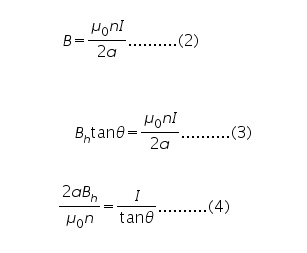
The left hand side of equation (4) is a constant and is called the reduction factor (K) of the given tangent galvanometer.
Now from equation (3) & (5), the horizontal intensity of earth’s magnetic field Bh is,
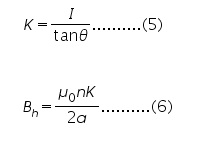
• Key
• Battery
• Ammeter
• Rheostat
• Commutator
• Tangent Galvanometer
Connections are made as shown in the figure given below, where K is the key, E the battery, A the ammeter, R the rheostat, C the commutator, and T.G the tangent galvanometer. The commutator can reverse the current through the T.G coil without changing the current in the rest of the circuit. Taking the average of the resulting two readings for deflection averages out, any small error in positioning the TG coil relative to the earth’s magnetic field Bh .
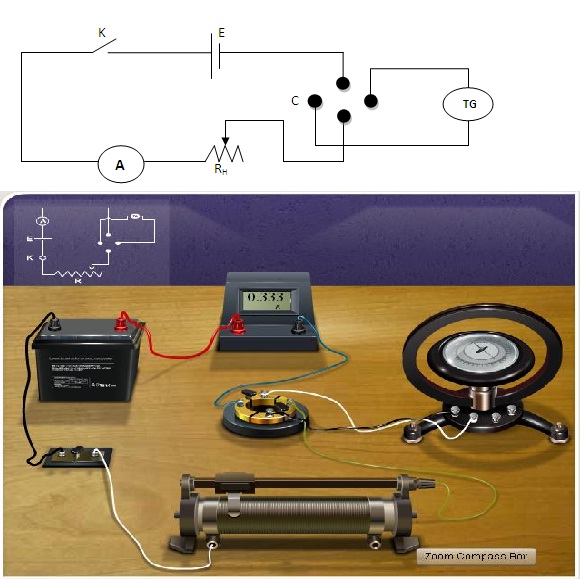
The initial adjustments are done as follows:
• The plane of the coil is made vertical by adjusting the levelling screws.
• The compass box alone is rotated so that the 90-90 line in the compass box is in the plane of the coil.
• The T.G as a whole is rotated till the Aluminium pointer reads 0-0.
• Note down the number of turns in the coil.
• A suitable current is allowed to pass through the coil.
• Note down the currrent as well as the deflection in T.G.
• Reverse the current and note the deflection again.
• Repeat the procedure for different values of current.
• Measure the radius of the coil from its perimeter.
• Determine the reduction factor and horizontal intensity of earth's magnetic field.
Number of turns in the coil =....
Circumference of the coil, «math xmlns=¨http://www.w3.org/1998/Math/MathML¨»«mn»2«/mn»«mi»§#960;«/mi»«mi»a«/mi»«/math»=......cm
Radius of the coil, a =....cm
1. To determine the horizontal component of earth’s magnetic field (Bh):
The Horizontal component of earth's magnetic field (Bh) can be calculated using the formula,

2. To determine the reduction factor of T.G:
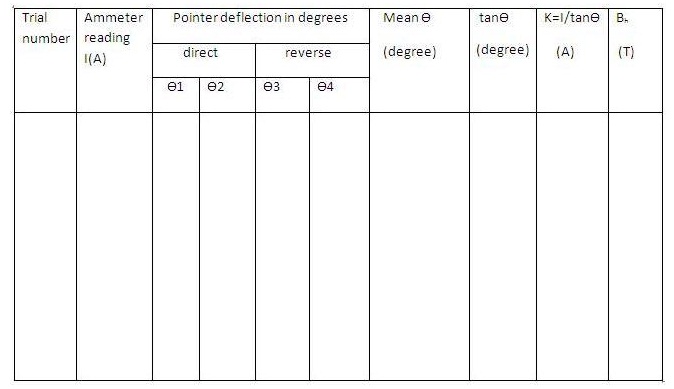
Note: Take deflection between 30 and 60 degrees.
From graph:
Reduction factor K of the tangent galvanometer can be detremined.
From the graph drawn as,
K = AB / BC
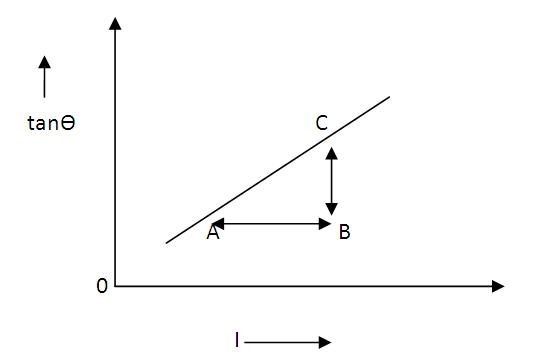
The reduction factor of the given tangent galvanometer, K =............A
Horizontal component of earth’s magnetic field, Bh =...........T
1. Nineteenth-century Scientific instruments. London Berkely:Sotheby Publications University of California Press,1983
2. A manual of experiments in physics: Laboratory instructions for College Classes.Joseph Sweetman Ames, William Julian Albert Bliss.
3. Maxwell, James. Treatise on electricity and magnetism. Cambridge: Cambridge University Press, 2010.
4. Introduction to Physical Science by Alfred.D.Bage,Forgotten books.
1. http://en.wikipedia.org/wiki/Galvanometer#Tangent_galvanometer
2. www.mccc.edu/~huangj/documents/gal.pdf